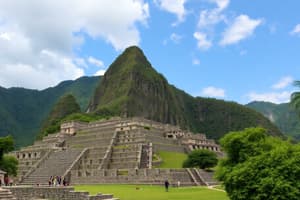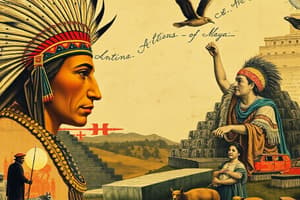Podcast
Questions and Answers
Which of these societies lived in longhouses?
Which of these societies lived in longhouses?
- Iroquois (correct)
- Chinook People
- Cahokia People
- Chumash People
Which society relied heavily on elk for food and subsistence?
Which society relied heavily on elk for food and subsistence?
- Cahokia People
- Hopewell People
- Chinook People (correct)
- Chumash People
Which society engaged in extensive trade networks reaching Florida and the Rocky Mountains?
Which society engaged in extensive trade networks reaching Florida and the Rocky Mountains?
- Hopewell People
- Chumash People
- Chinook People
- Cahokia People (correct)
Which society constructed giant plank houses using cedar trees?
Which society constructed giant plank houses using cedar trees?
Which society had the largest known settlement in their region, with a population estimated at 10,000-30,000 people?
Which society had the largest known settlement in their region, with a population estimated at 10,000-30,000 people?
Which of the following statements accurately reflects the diversity of Native American cultures before European arrival?
Which of the following statements accurately reflects the diversity of Native American cultures before European arrival?
The Aztec civilization is known for its capital city, Tenochtitlan, which was notable for its:
The Aztec civilization is known for its capital city, Tenochtitlan, which was notable for its:
What was a key factor in the Inca Empire's success, as discussed in the content?
What was a key factor in the Inca Empire's success, as discussed in the content?
Which of the following features was NOT a commonality shared by the Aztec, Maya, and Inca civilizations?
Which of the following features was NOT a commonality shared by the Aztec, Maya, and Inca civilizations?
The Pueblo people, known for their distinct architecture and social organization, inhabited which region of North America?
The Pueblo people, known for their distinct architecture and social organization, inhabited which region of North America?
What is a key characteristic of the Ute people, as described in the content?
What is a key characteristic of the Ute people, as described in the content?
Which of the following is NOT a characteristic of the Maya civilization?
Which of the following is NOT a characteristic of the Maya civilization?
Which of the following statements accurately reflects the Aztec religious practices as presented in the content?
Which of the following statements accurately reflects the Aztec religious practices as presented in the content?
Flashcards
Chinook People
Chinook People
Coastal settlers in fishing villages; relied on elk.
Chumash People
Chumash People
Settlers in California who lived in plank houses using cedar.
Hopewell People
Hopewell People
Reside in the Mississippi Valley; used fertile soil for farming.
Cahokia People
Cahokia People
Signup and view all the flashcards
Iroquois
Iroquois
Signup and view all the flashcards
Native American cultures
Native American cultures
Signup and view all the flashcards
Aztec Empire
Aztec Empire
Signup and view all the flashcards
Maya civilization
Maya civilization
Signup and view all the flashcards
Inca Empire
Inca Empire
Signup and view all the flashcards
Maize Cultivation
Maize Cultivation
Signup and view all the flashcards
Pueblo People
Pueblo People
Signup and view all the flashcards
Ute People
Ute People
Signup and view all the flashcards
Cultural diversity
Cultural diversity
Signup and view all the flashcards
Study Notes
Unit 1 Topic 2: The Americas Before European Arrival
- Native American peoples before European arrival developed diverse cultures, varying greatly by region.
- The common stereotype of Native Americans as solely nomadic hunter-gatherers is inaccurate.
- Native American societies encompassed a wide range of practices and social structures, from fishing villages to settled agricultural communities.
Central and South America
- Three major civilizations emerged in Central and South America, each with complex societies:
- Aztec (Mexica)
- Maya
- Inca
Aztec (Mexica)
- Capital: Tenochtitlan, a city of 300,000 people at its peak.
- Developed a written language and intricate irrigation systems.
- Religious practices: Human sacrifice was part of a fertility cult aimed at ensuring prosperity.
Maya
- Located on the Yucatan Peninsula.
- Constructed large cities, sophisticated irrigation and water storage systems.
- Built monumental stone temples and palaces for rulers considered divine.
Inca
- Established in the Andes Mountains along the Pacific Coast (modern-day Peru).
- Controlled an empire of 16 million people, spanning 350,000 square miles at its peak.
- Key to Success: Elaborate irrigation systems enabled cultivation of potatoes and other crops in fertile mountain valleys.
Commonalities Across Civilizations
- Maize Cultivation: All three civilizations cultivated maize, which spread north, supporting economic growth, settlements, advanced irrigation, and social structures in the American Southwest.
North America
- Native populations in North America demonstrated remarkable diversity, varying greatly across numerous regions.
Southwest
- Pueblo People:
- Present-day New Mexico and Arizona.
- Sedentary farmers of maize and other crops.
- Built multi-storied adobe and masonry homes, including cliff dwellings.
- Organized societies with administrative, religious, and craft centers.
Great Plains and Great Basin
- Arid regions supported nomadic hunter-gatherer groups.
- Ute People:
- Lived in small, egalitarian kinship-based groups, requiring vast hunting and gathering territories.
Pacific Northwest
- Coastal settlers in fishing villages relied on abundant elk in the forests.
- Chinook People: Large plank houses, accommodating up to 70 people, were constructed from abundant cedar.
- Chumash People:
- Lived further south in present-day California.
- Hunter-gatherers maintaining permanent settlements in resource-rich areas.
Mississippi River Valley
- Fertile soil supported settled agricultural societies.
- Hopewell People:
- Lived in towns of 4,000-6,000 people.
- Engaged in long-distance trade that extended into Florida and the Rocky Mountains.
- Cahokia People:
- Largest settlement in the region, with a population of 10,000-30,000 at its peak.
- Controlled by powerful chieftains, overseeing trade networks.
Northeast
- Iroquois:
- Lived in villages with several hundred inhabitants, cultivating maize, squash, and beans.
- Built and occupied long houses, housing 30-50 family members.
Studying That Suits You
Use AI to generate personalized quizzes and flashcards to suit your learning preferences.




